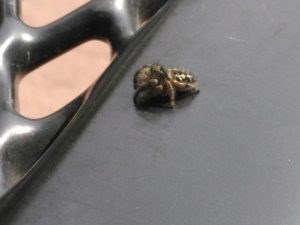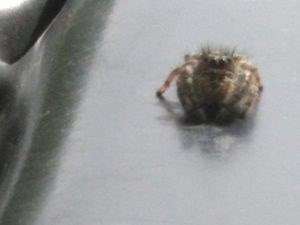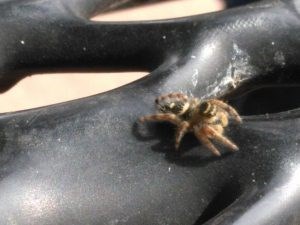This content was originally published by the Longmont Observer and is licensed under a Creative Commons license.
It’s October and Halloween is coming up, so I thought I’d focus on some of the critters associated with the holiday. The first in the series is spiders. Specifically, I’m going to focus on jumping spiders because they are my favorite. Perhaps not everybody thinks they are small and cute like I do, but they are amazing hunters nonetheless, and completely harmless to humans. They remind me of little clowns and they are very curious and athletic.

Colorado has at least 45 species of jumping spiders. One of the most common species of jumping spider we have in Longmont is the bold jumping spider, Phiddipus audax. They are small, only 4-12 millimeters in length and have a fuzzy appearance. Many jumping spiders in Colorado are brightly colored. The usual color patterns are black, brown, or grey, but you can also find orange or red patterns. The black, brown, or grey spiders will usually have a brightly colored patch which ranges from metallic blues and greens to red and yellow or copper and silver. The area around the jaw may also have a metallic color to it. The area of their body containing the head and legs is longer than it is wide. The rest of the body is elongated. Males and females are different in appearance. The males are blacker in color while the females are more greyish-brown in color. Jumping spiders have a unique eye pattern. Their eyes are either in three or four rows, but the front pair of eyes are larger than the rest and point forward. The smaller eyes are fixed and don’t move.
Jumping spiders have extremely good eyesight which makes them excellent hunters. They are able to detect colors, shapes, and depth of field. Some species are even able to detect ultraviolet light which helps in detection of mates or rivals. Jumping spiders use the small eyes on the sides of their head to detect movement. When they detect movement, they turn their large eyes toward the area. They don’t use webs to catch their prey, but they stalk and pounce on prey instead.
Jumping spiders can jump several body lengths, and when they find prey, they will slowly stalk it and jump on it suddenly. Some people compare this behavior to that of a cat stalking its prey. Contrary to what you might think, jumping spiders don’t have large, muscular legs. Their jumping ability is produced by hydraulic changes of fluid pressure in their legs. Contractions of muscles force body fluids into the hind legs, causing them to extend quickly and thus allowing the spider to jump. Jumping spiders also produce a silk line while hunting that acts to catch them if they fall. These lines may also contain pheromones that play a role in mating.

Studies have shown that jumping spiders are capable of learning and recognizing colors and can adapt their hunting behaviors accordingly. Rather than simply hunting in a straight line, some jumping spiders may even take a circuitous route to get to their prey. There is still a lot of research going on to learn more about the fascinating hunting behavior of jumping spiders. Jumping spiders hunt a variety of prey items, and some even specialize in a particular prey item such as ants. The bold jumping spider, found in Longmont, will even eat prey that have been caught in another spider’s web or will eat the spider occupying that web. Insects comprise the diet of the majority of jumping spiders, but some species will include nectar in their diet.
Jumping spiders also behave differently than other spiders when they are found. When detected, jumping spiders will turn toward the perceived threat rather than run away. However, jumping spiders are really relatively docile and will only bite if you try to handle them. Their jaws aren’t really strong enough to break the skin of humans, but if they do manage to do so, the bite usually only produces some mild discomfort.
Most jumping spiders only live for about a year. The most common species are not quite mature when winter approaches, but other species mature in the fall. Jumping spiders construct silken shelters to spend the winter in, and emerge in the spring and mature if they haven’t already done so. For those species that don’t mature until spring, the males will mature a few weeks before the females. In those species that mature in the fall, mating occurs in the fall and the females will survive until spring while the males will die in the fall.

Jumping spiders have very elaborate mating rituals and the bright colors found in their markings may play a role. In general, the males will display the iridescent parts of their body to the females, which includes hairs on the body. Males also perform a sort of courtship “dance,” moving side to side or in a zig zag pattern. They may drum on the ground to create vibrations that attract females. Recent research has shown that the males may also produce some kind of auditory signal that resembles drum rolls or buzzes. Larger males with more ultraviolet iridescence tend to be more successful at mating, but this also makes them more vulnerable to predation.
When the eggs mature, the female builds another silken retreat and she produces an egg sac. The female stays with the eggs until they hatch. She may produce several egg sacs during the course of the summer. Spiderlings disperse either by crawling or by a process called ballooning. The spiderlings produce a silk thread that is caught by the wind and then carries the spiderlings.
The bold jumping spider is likely to be seen around or even in houses. The next time you spot one of these, take some time to watch it. You may find yourself having begrudging respect for these clownish hunters!


